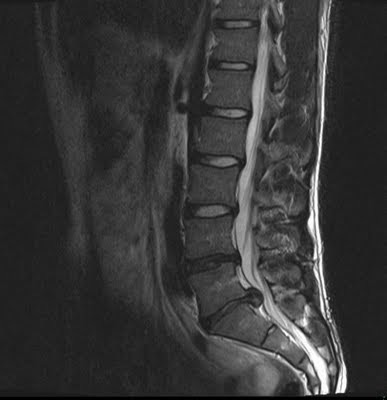Dr Creaney sees over 1,000 new patients per year. Approximately a third of these patients suffer from back or neck pain.
Common received wisdom states that the cause of back pain can’t be diagnosed. This isn’t true. Muscular, Disc-related, Facet joint related and Sacro-iliac joint related back pains can all be diagnosed and succesfully treated.
There are many causes of back pain including:-
- Posture - weak muscles in the back cause strain on the discs, small joints and ligaments. This simple ‘mechanical’ lower back pain can often be treated with an exercise programme
- Disc-related or ‘Discogenic’ pain - a lot of pain in the back comes from wear and tear of the intervertebral discs. These discs can tear leading to acute spasm in the lower back (‘locked back’) or they can age prematurely due to posture. Recently ‘MODIC’ change has been identifed as a common feature of disc-related back pain, and much research is focused on this at present
- ‘MODIC’ type change - seen on MRI, damaged disc material may erode into adjacent vertebrae, causing localised back pain. Much interest has been sparked on this subject recently. A group of researchers in Scandinavia have linked the condition with low grade infection and have treated a group of patients with antibiotics with some success. The treatment has not gained general acceptance within the worldwide medical community yet.
- ‘Slipped-disc’ (a.k.a. Prolapsed Disc) can press against a spinal nerve root. This leads to sciatica (radiculopathy), which causes pain to radiate down the leg to the calf.
- Facet joint pain/Lumbar Spondylosis - these small joint in the back can become arthritic or inflammed leading to localised pain in the back.
- Sacro-iliac joint pain - these joints lead to very low back and buttock pain. This is more common in pregnancy when the joints become hyper-mobile. They can also become inflamed in certain types of inflammatory arthritis
- Inflammatory Arthritis - Rheumatoid Arthritis or Anklylosing Spondylitis, where the joints are being attacked by the body's own immune system.
- Spinal Stenosis - seen in people with advanced ‘wear & tear’ arthritis in the spine. Overgrown bone and soft tissue start to encroach upon the spinal canal and spinal cord, effectively squashing them. Symptoms are often described as ‘Spinal Claudication’ - pain and numbness in legs when walking.
- Serious Conditions - although rare, Cancer, Infections & Osteoporotic Fractures can occasionally lead to serious back pain.
Treatment
- Physiotherapy / Osteopathy - therapists use a combination of Manual Therapy (Joint manipulation and mobilisations), Exercise (Pilates, Core Stability) and other physical therapies such as therapeutic ultrasound to rehabilitate people with back pain. Physical Therapy remains the first modality used in the vast majority of back pain presentations.
- Therapeutic Injections - Both the Sacro-iliac joints and Facet joints can be targeted for steroid injection if they are determined to be the cause of the back pain. Steroid is usually effective for a few months. If successful, a more permanent procedure known as ‘Radio-frequency’ ablation can be used to block the nerves supplying the painful joints.
- Epidural Injections - Injection of local anaesthetic and steroid into the epidural space can be very effective for ‘sciatica’, where a nerve is being compressed by a ‘Slipped Disc’. The medical term for this is ‘Radiculopathy’. Different routes into the epidural space can be taken - Caudal, Interlaminar and Transforaminal.
- Surgery - there are many types of surgery for back pain, if surgery is necessary, Dr Creaney will help you to find a local appropriate surgeon, and will make the necessary referral.
- Provocation Discography - if a particular degenerate disc is believed to be the main pain generator, this procedure is necessary prerequisite for confirmation. Under X-ray guidance, saline is injected into the disc. If the injection reproduces your back pain (‘concordant pain’) then there is a high level of confidence that the correct disc has been identified.
- Fusion or Disc Replacement - this is an ‘end-stage’ or ‘last resort’ procedure. Where a particular disc is identified as the main back pain generator it can be removed. The space is either packed with bone and ‘fused’ or an artificial disc is inserted.
- Laminectomy & Microdiscectomy - Where a herniated disc is compressing a spinal nerve root. A ‘decompression’ is necessary where the encroaching bony or disc material is excised.



